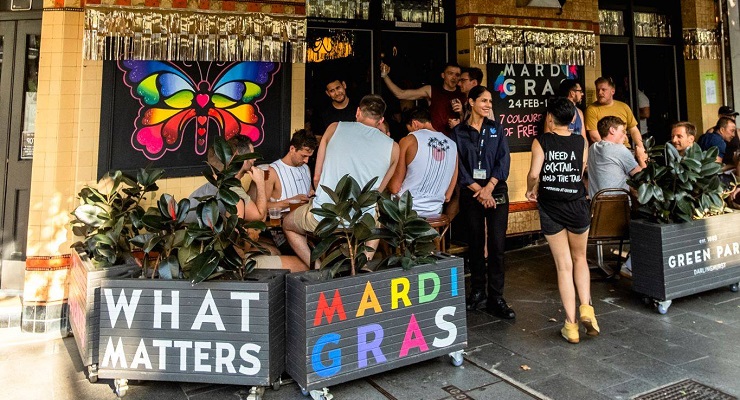Calling last drinks on a 127-year-old pub should have us all piling on to the streets to fight the good fight against the institutions’ war on life.
The news that Darlinghurst’s Green Park Hotel will close after 127 years of continuous operation echoed round the country when it was announced a few days ago.
This was for the usual reasons: journalists’ watering holes are always made more of a fuss of than other folks’ pubs, and the Green Park has been that over many decades — as well as a gathering place for crims, bohemians, the Push and latterly the LGBTIQ community and its predecessors.
But what makes its passing so notable is that it’s not being killed for apartments, but by a deal between its mega-landlord owners and St Vincent’s Hospital as part of its endless expansion into the neighbourhood.
This rich focus of community, history, continuity, meaning will be replaced by a suicide prevention centre. And thereby hangs a tale of modernity: the conjunction of capital and discursive power, and the war of institutions against life.
The deal between Solotel and St Vincent’s was done on the quiet and suddenly announced. The vendors don’t give a damn about the pub’s continuity; St Vincent’s doesn’t seem to have considered the social case for not taking the pub out of commission.
Indeed one doctor celebrated its demise, noting that it would now be a place that “treated” people without alcohol, as if that was all a pub was.
And that is a very revealing remark about the mindset of the “prevention” industry — that it can see no difference between a pub, where life intersects and happens at multiple levels, and a bureaucratic/therapeutic institution grounded on a power relationship where people are assigned the roles of doctors and citizens, rather than equals.






The notion that destroying a celebrated pub to create a clinic is a like-for-like exchange is the sort of thing someone in the ’50s would have put in a sci-fi dystopia.
Now it’s here, courtesy of the prevention and treatment industry. More particularly, courtesy of the treatment industry’s massive ability to self-reproduce the vast energy it expends on doing so.
In the three fields that consume enormous resources — alcohol and drug abuse, suicide prevention, and violence against women — there is little evidence that these generic programs make much difference, and some possibility that they may make things worse due to the complex interplay of selfhood, power and “voice” in social life.
One possibility is that the relentlessness of such discourses produce a “suicidal subject”, an identity for someone to slot into. That would certainly explain the paradoxical course of LGBTIQ status and suicidality over several decades since the ’70s.
To try to get St Vincent’s to rethink its imperatives would be to howl in the wind. The same with Black Dog, Beyond Blue, various cancer prevention groups, or any number of powerful orgs. Big prevention rolls on, its leading figures interpreting its self-perpetuation as therapeutic success.
The sector is filled with people who have an appetite for micropower over others, and who have no interest in genuinely reflecting as to whether they are doing more bad than good. The finding that after the untold millions spent on prevention in Australia suicide rates have returned to a long-term mean will make no difference to them at all.
The hospitals’ institutional drive has long transformed from service to institutional growth. Not even for profit; simply for power, a nihilism masked by a residual ethic of concern.
Were a pub with a strong LGBTIQ presence to be replaced by a Hungry Jack’s the uproar would be instant, even if the spatial concentration of LGBTIQ people has diminished somewhat. But who’s going to object to the expansion of a hospital?
Well, people should. Raise hell. In 20 years this form of therapeutic prevention will join psychiatry’s long and dishonourable history of fad approaches — lobotomy, refrigerator mothers, behavioural reconditioning — in the museum.
In the meantime note this: the hospitals and the state defined homosexuality as a crime and disease until 1974, and closed down its gathering places. Now they define it as a vulnerability to be protected — and close down its gathering places.
The one continuity is the institutions’ war on life. This is the war we’re all in: to try to keep some area of life — raw, risky, joyful, surprising, unpredictable — protected from the intersection of capital and discursive control that is emerging as the new order.
To have cities that are something other than a giant dormitory/hospital/mall agglomeration. The “small” matters such as the killing of a pub aren’t small at all; they’re where life happens, and where the fight has to be had.
If something like this, or the attempt to put an Apple store in Melbourne’s Fed Square, or any number of other matters, makes you feel a particular sense of dismay, a keen sense of loss and destruction, it’s worth listening to that emotion and acting on it politically.
The Green Park can be saved as a pub, and with that a principle of life asserted. Or is the most prominent LGBTIQ community outside of San Francisco just going to lie down like a rainbow road crossing and be ridden over unto dissolution?
The institutions, they make a desert and they call it care, and we are in a fight for our lives.




Save up to 50% on a year of Crikey.
This extraordinary year is almost at an end. But we know that time waits for no one, and we won’t either. This is the time to get on board with Crikey.
For a limited time only, choose what you pay for a year of Crikey.
Save up to 50% or dig deeper so we can dig deeper.
See you in 2021.
Peter Fray
Editor-in-chief of Crikey








